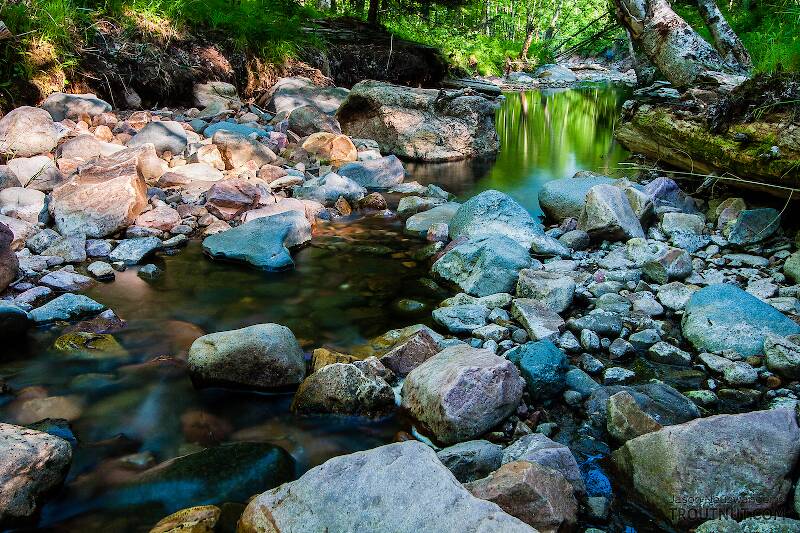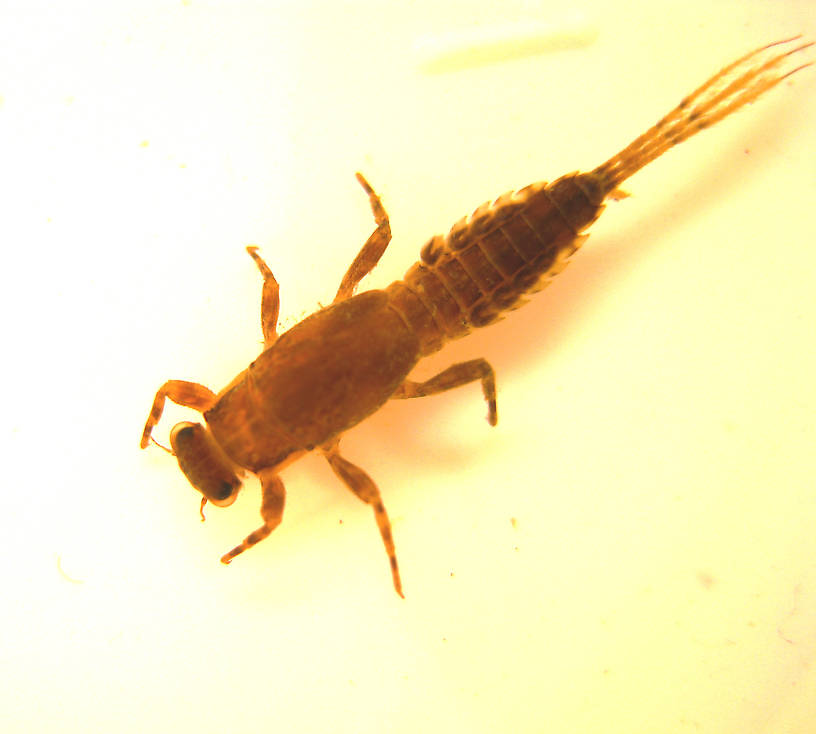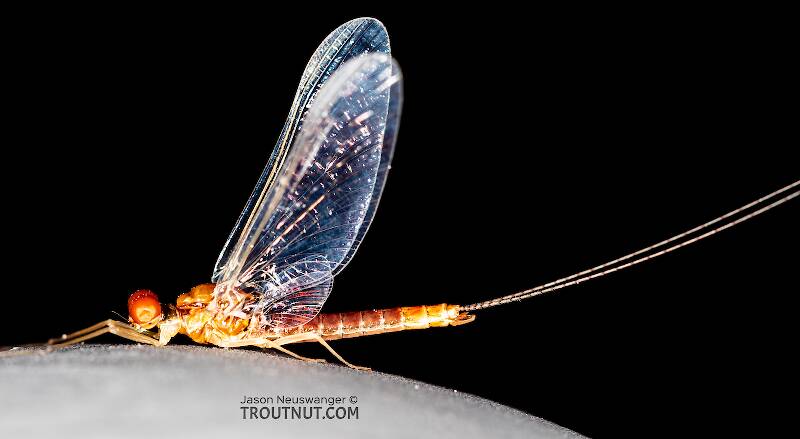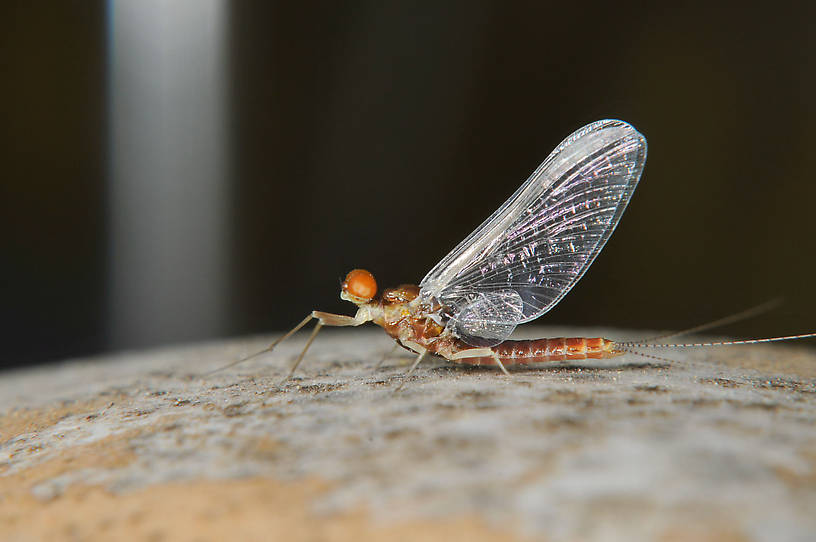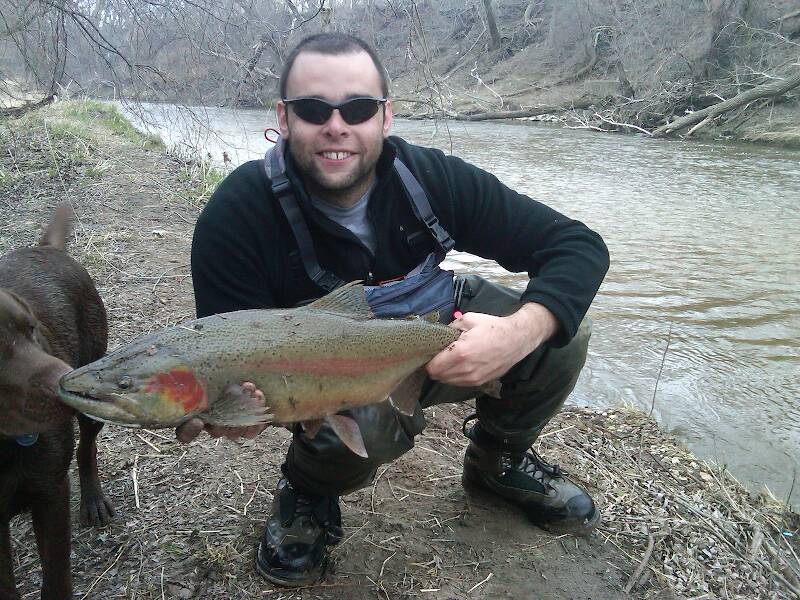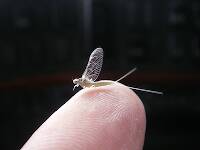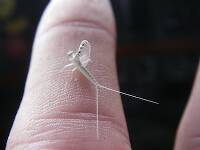
Salmonflies
Pteronarcys californica
The giant Salmonflies of the Western mountains are legendary for their proclivity to elicit consistent dry-fly action and ferocious strikes.
Featured on the forum

This dun emerged from a mature nymph on my desk. Unfortunately its wings didn't perfectly dry out.

Troutnut is a project started in 2003 by salmonid ecologist Jason "Troutnut" Neuswanger to help anglers and
fly tyers unabashedly embrace the entomological side of the sport. Learn more about Troutnut or
support the project for an enhanced experience here.
This topic is about the Mayfly Species Ephemerella dorothea infrequens
Ephemerella dorothea infrequens (formerly Ephemerella infrequens), together with its often smaller and later hatching sibling Ephemerella excrucians, make up the most important Western hatches. They go by several common names but are best known as Pale Morning Duns (PMD's). They are rivaled only by the many baetid species that typically bookend them. In terms of availability, consistency and abundance (not to mention their convenient timing and preference for beautiful weather), they have no rival. They can run in size from a large 14 to a small 16 and various shades of illusive yellowish creams, sulfurs, and even yellowish greens, depending on the system they inhabit.This taxon used to be considered the separate species Ephemerella infrequens, but entomologists now regard it as a subspecies together with the small eastern Pale Evening Dun hatch Ephemerella dorothea dorothea. There is another related listing of significance common in California and the Southwest that has undergone revision. The large (often exceeding 10 mm) Ephemerella mollitia is now considered synonymous with d. infrequens.
While it is not the normal policy of TroutNut to list subspecies as separate taxa, d. infrequens and d. dorothea are so important and distinct from each other in terms of geography, appearence, and angling tradition that they warrant an exception.
Example specimens
Wbranch on Feb 17, 2008February 17th, 2008, 5:57 am EST
These mayflies look more like the Sulfurs I see on the Delaware system than the PMD's I see in Montana. The Montana mayfly has a distinct yellow leading edge to an overall light dun gray wing and the abdomen and thorax have a more light greenish/yellow cloration so how is it that Infrequens is now known as Ep Dorothea Dorothea?
Catskill fly fisher for fifty-five years.
Taxon on Feb 17, 2008February 17th, 2008, 6:26 am EST
Matt-
so how is it that Infrequens is now known as Ep Dorothea Dorothea?
Well, that is not exactly correct. As a result of taxonomic reclassification, the species which was known as Ephemerella dorothea became subspecies E. dorothea dorothea, and both the species known as Ephemerella infrequens, and the species known as E. mollitia become subspecies E. dorothea infrequens. See below copied from Mayfly Central:
Ephemerella dorothea dorothea (Needham), 1908
- Ephemerella dorothea Needham, 1908 (orig.)
Ephemerella dorothea infrequens (McDunnough), 1924
- Ephemerella infrequens McDunnough, 1924 (orig.)
- Ephemerella mollitia Seemann, 1927 (syn.)
Troutnut on Feb 17, 2008February 17th, 2008, 7:09 am EST
What Roger said.
(He sure makes things easy!)
(He sure makes things easy!)
Jason Neuswanger, Ph.D.
Troutnut and salmonid ecologist
Troutnut and salmonid ecologist
JAD on Feb 17, 2008February 17th, 2008, 9:40 am EST
That's a different Loop wing than I ever saw WB how does it perform
JAD
JAD
They fasten red (crimson red) wool around a hook, and fix onto the wool two feathers which grow under a cock’s wattles, and which in colour are like wax.
Radcliffe's Fishing from the Earliest Times,
Taxon on Feb 17, 2008February 17th, 2008, 9:59 am EST
Matt-
Probably not, as the vast majority of Jason's collecting/photographing is from the Midwest (Wisconsin) and the Northeast (New York), and Ephemerella dorothea infrequens is only present in the West. However, they are present in Alaska, so there is always hope.
Are there any pictures of Ephemerella dorothea infrequens on this site?
Probably not, as the vast majority of Jason's collecting/photographing is from the Midwest (Wisconsin) and the Northeast (New York), and Ephemerella dorothea infrequens is only present in the West. However, they are present in Alaska, so there is always hope.
Wbranch on Feb 17, 2008February 17th, 2008, 11:33 am EST
JAD,
It performs quite well when dressed as an Eastern Ep Dorothea (Sulfur)with the light yellow to light orange abdomen and thorax with a medium dun hackle and equally well when dressed as a Western Ep Infrequens (PMD) with the typical light greenish abdomen and thorax and light cream hackle. The tail fibers are soft and meant to sink. Then the fly sits more or less vertical in the water and the wing is actually what would be called a "Quigley style".

The bottom right row has a similar tie except the body is meant to replicate the nymphal shuck and instead of a "Loop" the wing is composed out of a ball of Antron yarn.
It performs quite well when dressed as an Eastern Ep Dorothea (Sulfur)with the light yellow to light orange abdomen and thorax with a medium dun hackle and equally well when dressed as a Western Ep Infrequens (PMD) with the typical light greenish abdomen and thorax and light cream hackle. The tail fibers are soft and meant to sink. Then the fly sits more or less vertical in the water and the wing is actually what would be called a "Quigley style".

The bottom right row has a similar tie except the body is meant to replicate the nymphal shuck and instead of a "Loop" the wing is composed out of a ball of Antron yarn.
Catskill fly fisher for fifty-five years.
Wiflyfisher on Feb 17, 2008February 17th, 2008, 1:59 pm EST
Last summer while out West we had a sporatic hatch of E. infrequens and all I had with me at the time were dorothea emergers. They worked fine on the big sipping rainbows. The fish were really keyed in on the emergers just underneath the film. My emerger pattern had a short, white rabbit fur wing tied wetfly style with a pale yellow body (barbless hook). I think the trout knew my pattern was a subspecie of the specie so they readily took it.
So Roger, since E. dorothea dorothea is now a subspecies does that mean there is another "species" known as E. dorothea?
Species: E. dorothea
Subspecies: E. dorothea dorothea
the species which was known as Ephemerella dorothea became subspecies E. dorothea dorothea,
So Roger, since E. dorothea dorothea is now a subspecies does that mean there is another "species" known as E. dorothea?
Species: E. dorothea
Subspecies: E. dorothea dorothea
John S.
https://WiFlyFisher.com
https://WiFlyFisher.com
Kinzua on Feb 17, 2008February 17th, 2008, 2:32 pm EST
WB,
Can you reveal the tail materials?
John
Can you reveal the tail materials?
John
Taxon on Feb 17, 2008February 17th, 2008, 4:55 pm EST
John-
Ephemerella dorothea dorothea and E. dorothea infrequens collectively constitute E. dorothea. Of course, this begs another question, which is, what is the fundamental difference between a species and a subspecies? Unfortunately, I have never heard (what I would consider to be) a crisp answer to that question. However, perhaps Konchu will step in at this point, and bail me out.
So Roger, since E. dorothea dorothea is now a subspecies does that mean there is another "species" known as E. dorothea?
Species: E. dorothea
Subspecies: E. dorothea dorothea
Ephemerella dorothea dorothea and E. dorothea infrequens collectively constitute E. dorothea. Of course, this begs another question, which is, what is the fundamental difference between a species and a subspecies? Unfortunately, I have never heard (what I would consider to be) a crisp answer to that question. However, perhaps Konchu will step in at this point, and bail me out.
Troutnut on Feb 17, 2008February 17th, 2008, 5:11 pm EST
what is the fundamental difference between a species and a subspecies? Unfortunately, I have never heard (what I would consider to be) a crisp answer to that question.
There is a pretty good answer on Wikipedia. I would imagine there's still quite a bit of subjectivity in interpreting the evidence about whether different insect variations are subspecies or not, and I would guess there are lots of species and subspecies that haven't been correctly classified just yet because people haven't had enough time to study them closely. Konchu would know way more about that I'm sure.
Jason Neuswanger, Ph.D.
Troutnut and salmonid ecologist
Troutnut and salmonid ecologist
Taxon on Feb 17, 2008February 17th, 2008, 5:51 pm EST
Thanks, Jason. That is a reasonably crisp definition. I have parsed the following from it:
So, when one applies the above definitions to our specific discussion, the primary stock (or species) would be Ephemerella dorothea, the nominate subspecies would E. dorothea dorothea, and the geographically isolated subspecies would be E. dorothea infrequens. Or, so it seems to me.
A subspecies is a taxonomic group less distinct than the primary stock (species) from which it originates. The characteristics attributed to subspecies are generally derived from changes that have taken place or evolved as a result of geographical distribution or isolation from the primary species or nominate subspecies, which is a subspecies indicated by the repetition of the specific name.
So, when one applies the above definitions to our specific discussion, the primary stock (or species) would be Ephemerella dorothea, the nominate subspecies would E. dorothea dorothea, and the geographically isolated subspecies would be E. dorothea infrequens. Or, so it seems to me.
Wbranch on Mar 11, 2008March 11th, 2008, 2:10 pm EDT
Kinzua,
Sorry it has taken me so long to get back to you. My computer was down for two weeks and then I went from AOL to Comcast and that took another week to get the installation.
I use a feather from a turkey but don't know from what specific area of the bird. Maybe some one here is more familiar with turkey feathers and can chime in to tell us where it is from. I like them better than PT fibers because they are all the same length, not tapered like PT and broader.
I cut out between 4 and 8 fibers, depending on the hook size, from the area above the black band.


Sorry it has taken me so long to get back to you. My computer was down for two weeks and then I went from AOL to Comcast and that took another week to get the installation.
I use a feather from a turkey but don't know from what specific area of the bird. Maybe some one here is more familiar with turkey feathers and can chime in to tell us where it is from. I like them better than PT fibers because they are all the same length, not tapered like PT and broader.
I cut out between 4 and 8 fibers, depending on the hook size, from the area above the black band.


Catskill fly fisher for fifty-five years.
Entoman on May 7, 2014May 7th, 2014, 6:43 am EDT
Revisiting this thread since we are approaching PMD season and a few questions posted at the time weren't answered completely.
Matt - your observations that they look more like your Delaware bugs is astute. The western subspecies dorothea infrequens has incredible variation with many forms that paradoxically look much closer to their sister subspecies back East than their own. I've seen 'em from a peachy orange size 12 to a greenish yellow size 16, with all kinds of differences in between. For example, a variety that hatches on the Deschutes in OR is virtually indistinguishable in size, form and color from the pale yellowish ones that hatch in the limestone country of PA. It looks much different from the larger orange jobs hatching in the next river over. On Hat Creek (and most Sierra Watersheds) in CA they are large and peachy. On Fall River right around the corner, they are smaller and greenish. Then there's the confusion caused by the virtually identical (and equally variable) excrucians (prev. inermis) thrown into the mix. The most brilliant entos in the world have trouble telling them all apart. There is much left to do with this group of critters.
Oh, we do have a few pictures of them in the encyclopedia now, with many more to come in the future.
Matt - your observations that they look more like your Delaware bugs is astute. The western subspecies dorothea infrequens has incredible variation with many forms that paradoxically look much closer to their sister subspecies back East than their own. I've seen 'em from a peachy orange size 12 to a greenish yellow size 16, with all kinds of differences in between. For example, a variety that hatches on the Deschutes in OR is virtually indistinguishable in size, form and color from the pale yellowish ones that hatch in the limestone country of PA. It looks much different from the larger orange jobs hatching in the next river over. On Hat Creek (and most Sierra Watersheds) in CA they are large and peachy. On Fall River right around the corner, they are smaller and greenish. Then there's the confusion caused by the virtually identical (and equally variable) excrucians (prev. inermis) thrown into the mix. The most brilliant entos in the world have trouble telling them all apart. There is much left to do with this group of critters.
Oh, we do have a few pictures of them in the encyclopedia now, with many more to come in the future.
"It's not that I find fishing so important, it's just that I find all other endeavors of Man equally unimportant... And not nearly as much fun!" Robert Traver, Anatomy of a Fisherman
Oldredbarn on May 7, 2014May 7th, 2014, 12:10 pm EDT
truth be known...there were times out west I used my eastern Sulphers on them western trout and they didn't seem to mind. I was using our invaria though. Our eastern dorothea is a 19/20. 18's will suffice. :)
Spence
Spence
"Even when my best efforts fail it's a satisfying challenge, and that, after all, is the essence of fly fishing." -Chauncy Lively
"Envy not the man who lives beside the river, but the man the river flows through." Joseph T Heywood
"Envy not the man who lives beside the river, but the man the river flows through." Joseph T Heywood
Kschaefer3 on May 7, 2014May 7th, 2014, 12:25 pm EDT
truth be known...there were times out west I used my eastern Sulphers on them western trout and they didn't seem to mind. I was using our invaria though. Our eastern dorothea is a 19/20. 18's will suffice. :)
Spence
What kind of low brow fish were you fishing over? Taking an eastern invaria as a western dorothea...sickening. :)
Jmd123 on May 7, 2014May 7th, 2014, 12:43 pm EDT
Kyle, perhaps those fish aren't quite the nerdy entomologists we perceive them to be. After all, I have been quite frequently known to throw an Adams as an imitation (Spence is having a fit of apoplexy right now I'm sure) and it's worked more often than not...
Jonathon
Jonathon
No matter how big the one you just caught is, there's always a bigger one out there somewhere...
Oldredbarn on May 7, 2014May 7th, 2014, 2:50 pm EDT
After all, I have been quite frequently known to throw an Adams as an imitation (Spence is having a fit of apoplexy right now I'm sure) and it's worked more often than not...
Jonathon
Jonathon...I was thinking about you last night. Davey McPhail has some beautiful YouTube tying videos out. I found one of him tying a Comparadun version of a egg-laying female Adams...You know that you popped in to my mind immediately, right after I tried to figure out if the egg-sac would be visible in the dun stage? :)
Kyle...I may have caught those western fish asleep at the wheel. I have a secret caddis pattern I tie that works well here in Michigan in either black or brown...Size 16. In 1995 on the Madison it could of been my only fly. I couldn't understand why I had just spent all damn winter tying up all those boxes of other things! I would of won a one-fly there with it that year.
Sometimes these fishes reveal that indeed they have rather small, one-track, brains.
Spence
"Even when my best efforts fail it's a satisfying challenge, and that, after all, is the essence of fly fishing." -Chauncy Lively
"Envy not the man who lives beside the river, but the man the river flows through." Joseph T Heywood
"Envy not the man who lives beside the river, but the man the river flows through." Joseph T Heywood
Jmd123 on May 7, 2014May 7th, 2014, 3:15 pm EDT
Spence, my first trout season back up here in the north country I took a Female Adams (think it was a #12, my favorite size) out on the Sage Lake Road section of the Rifle in late may or early June. Fishing during the middle of the day into early evening, there were next to no insects on the water, but fish went just nuts over this fly. I brought 7 to hand but had like 50 strikes, probably most of them little guys, that I missed! I haven't tried to repeat that since but I might have to give that a try this season, perhaps experimenting with egg sac colors (since the Adams doesn't imitate anything - this fly had a yellow one) to see what drives them the most crazy out there.
And both of you guys, there have been many occasions when one single fly pattern was the ticket all day long or even for several trips in a row.
As I said, I think we spend a lot of time overestimating a fish's mind. And after all, we really have NO IDEA EXACTLY WHY a fish hits or rejects our fly, we can only guess from our own (human-brained, both emotional and analytical) viewpoints. I say who cares what the fish really thinks, so long as it works...but then again I find myself thinking, "those smallies are taking my rainbow KBF because it must look like a small bluegill" or "my POG bugger must be taken for a sculpin" or "they must think the black Woolly is a leech" or "maybe the dark brown Woolly represents a dragonfly larvae".
But then again, maybe they're just thinking, "What the hell is THAT?" And fish have only one way to investigate an object: with their MOUTHS.
Jonathon
And both of you guys, there have been many occasions when one single fly pattern was the ticket all day long or even for several trips in a row.
As I said, I think we spend a lot of time overestimating a fish's mind. And after all, we really have NO IDEA EXACTLY WHY a fish hits or rejects our fly, we can only guess from our own (human-brained, both emotional and analytical) viewpoints. I say who cares what the fish really thinks, so long as it works...but then again I find myself thinking, "those smallies are taking my rainbow KBF because it must look like a small bluegill" or "my POG bugger must be taken for a sculpin" or "they must think the black Woolly is a leech" or "maybe the dark brown Woolly represents a dragonfly larvae".
But then again, maybe they're just thinking, "What the hell is THAT?" And fish have only one way to investigate an object: with their MOUTHS.
Jonathon
No matter how big the one you just caught is, there's always a bigger one out there somewhere...
Oldredbarn on Jun 30, 2014June 30th, 2014, 4:05 pm EDT
These mayflies look more like the Sulfurs I see on the Delaware system than the PMD's I see in Montana. The Montana mayfly has a distinct yellow leading edge to an overall light dun gray wing and the abdomen and thorax have a more light greenish/yellow cloration so how is it that Infrequens is now known as Ep Dorothea Dorothea?
You know Matt, I think some of the confusion here can be traced back to the fact that the old E infrequens and E inermis were both called PMD's...Not unlike our E invaria and E dorothea being called Sulphers.
If you look at the pics under E excrucians (formerly E inermis) you may see a bug more familiar to you as the western PMD.
Confused the hell out of me in 1995 when I first fished Montana! :)
I'm just reviewing this a bit since I'm heading west at the end of July.
Matt...I'm stopping at the Bighorn for a couple days...Been tying up Ray Charles' and a fly tied by Mike Heck that JohnW gave me when he visited earlier this month. Any other suggestions...Tying up some small black caddis for that river as well and tiny, tiny, other things. :)
Spence
"Even when my best efforts fail it's a satisfying challenge, and that, after all, is the essence of fly fishing." -Chauncy Lively
"Envy not the man who lives beside the river, but the man the river flows through." Joseph T Heywood
"Envy not the man who lives beside the river, but the man the river flows through." Joseph T Heywood
Quick Reply
Related Discussions
Topic
Replies
Last Reply
0
Jun 29, 2020
by Wiflyfisher
by Wiflyfisher
3
Jul 22, 2014
by Entoman
by Entoman
10
Jul 27, 2008
by Phillyfired
by Phillyfired
Re: Public service announcement: PMDs aren't yellow
In Male Ephemerella excrucians Mayfly Dun by Troutnut
In Male Ephemerella excrucians Mayfly Dun by Troutnut
13
Aug 28, 2020
by Wiflyfisher
by Wiflyfisher

